
Anxiety disorders affect millions of people worldwide, often leading to sleep disturbances and increased stress levels. While treatments like therapy, meditation, and medication are effective, some individuals seek additional methods for relief. One option gaining attention is a weighted pillow for anxiety, designed to provide deep pressure stimulation (DPS)—a technique that applies gentle, even pressure to the body to promote relaxation. By engaging this sensory response, a weighted pillow for anxiety may help calm the nervous system and reduce stress.
But does a weighted pillow for anxiety truly work? Let’s examine the research behind DPS, its effects on stress and sleep, and how weighted pillows might contribute to anxiety relief.
What Is a Weighted Pillow?
A weighted pillow is a sleep or relaxation aid designed with added weight, typically using materials like:
- Microbeads or glass beads (similar to weighted blankets)
- Buckwheat hulls, a popular all-natural pillow filling
- Gel-infused or memory foam cores
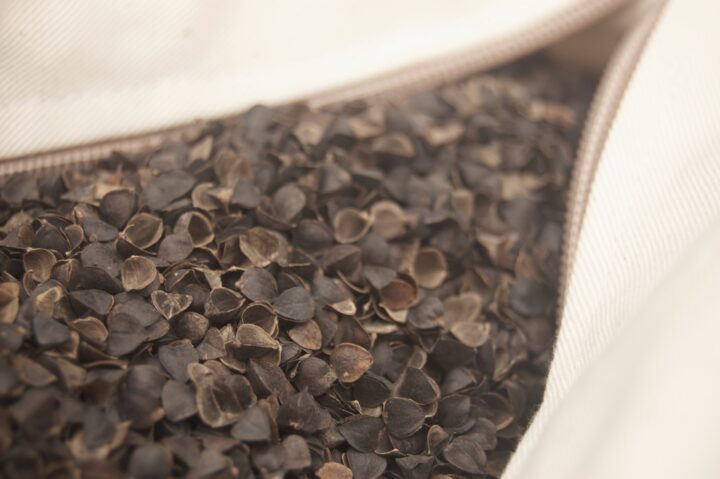
The key mechanism behind weighted pillows is deep pressure stimulation (DPS), a tactile therapy that mimics the calming effects of a hug or firm touch. This technique is already used in occupational therapy for individuals with anxiety, autism spectrum disorder (ASD), and sensory processing disorders.
How Deep Pressure Stimulation (DPS) Affects Anxiety
1. Reduces Cortisol (Stress Hormone) Levels
Anxiety triggers the release of cortisol, the body’s primary stress hormone. Excess cortisol can lead to a heightened state of alertness, making it difficult to relax or fall asleep.
A study published in the Journal of Sleep Medicine & Disorders found that DPS, as applied through weighted blankets, significantly reduced cortisol levels while increasing serotonin and melatonin—both crucial for relaxation and sleep. (Source)
This suggests that a weighted pillow could have a similar effect by applying localized pressure to the head, neck, and shoulders.
2. Increases Serotonin and Melatonin for Better Sleep
People with anxiety often experience sleep disturbances, including difficulty falling and staying asleep. Serotonin, a neurotransmitter that regulates mood, plays a key role in relaxation and is a precursor to melatonin, the hormone responsible for sleep-wake cycles.
Research on DPS suggests that applying gentle, consistent pressure can stimulate serotonin production, leading to a natural increase in melatonin levels. (Source)
This means that using a weighted pillow at night could encourage deeper, more restful sleep, particularly for those with anxiety-related insomnia.
3. Activates the Parasympathetic Nervous System (Rest-and-Digest Mode)
Anxiety keeps the body in a heightened state of arousal, activating the sympathetic nervous system (fight-or-flight response). This leads to increased heart rate, shallow breathing, and muscle tension.
Weighted products have been found to activate the parasympathetic nervous system—the body’s natural “rest-and-digest” mode—by reducing physiological arousal. (Source)
This physiological shift helps lower heart rate and breathing rate, promoting a sense of calmness.
Can a Weighted Pillow Help with Anxiety?
Although most research on DPS has focused on weighted blankets, vests, and compression therapy, the same principles may apply to weighted pillows.
Who Might Benefit from a Weighted Pillow for Anxiety?
A weighted pillow could be particularly helpful for:
- Individuals with Generalized Anxiety Disorder (GAD): Helps promote relaxation through consistent pressure.
- People with Sleep Disorders: Encourages the production of melatonin and serotonin.
- Those with Sensory Processing Sensitivities: Provides a calming, grounding sensation without overwhelming stimulation.
- Anyone Experiencing High Stress Levels: Supports relaxation during high-stress periods, such as work deadlines or travel.
Choosing the Right Weighted Pillow for Anxiety
When selecting a weighted pillow, consider:
- Weight: A pillow should be heavy enough to provide noticeable pressure but not uncomfortable. Most weighted pillows range from 3 to 10 pounds.
- Material: Look for breathable, organic fabrics. Egyptian cotton twill is a good compromise between comfort, durability and sustainability.
- Adjustability: Some options, like buckwheat-filled pillows, allow for adjustable firmness and weight by adding or removing hulls.
Should You Try a Weighted Pillow?
A weighted pillow for anxiety may offer a natural, science-backed way to reduce stress, improve sleep, and promote relaxation. While more research is needed specifically on weighted pillows, the existing data on Deep Pressure Stimulation (DPS) strongly supports their potential benefits.
For those struggling with anxiety-related restlessness or sleep disturbances, incorporating a weighted pillow into a holistic stress management plan could be a simple yet effective solution. If you’re looking for a natural way to feel more grounded at night, give our weighted pillow a try and experience the difference for yourself.
References
• Ackerley, R., Badre, G., & Olausson, H. (2015). Positive effects of a weighted blanket on insomnia. Journal of Sleep Medicine & Disorders.
• Penn Medicine. (2022). Weighted blankets for anxiety and sleep: Do they really work? Penn Medicine Blog.
• Ekholm, B., & Öhman, A. (2020). Deep pressure stimulation and its effects on sleep quality: A randomized controlled study. PMC Public Health.

Sleep is a universal experience, yet its complexity has puzzled humanity for centuries. From the evolutionary roots of sleep in ancient species to modern scientific breakthroughs, understanding sleep’s history provides insight into why it remains a cornerstone of health and well-being today.
This article explores how historical evidence shapes our current understanding of sleep, tracing its significance through cultural beliefs, religious philosophies, and scientific discoveries.
Early Evidence of Sleep
Fossil and Evolutionary Clues About Sleep in Early Species
The origins of sleep stretch back billions of years. Even single-celled organisms show signs of rhythmic activity resembling rest. Fossil evidence suggests that sleep likely evolved as a survival mechanism, conserving energy and enhancing alertness during daylight hours.
Sleep Patterns in Early Humans: The Hunter-Gatherer Era
Early humans likely followed polyphasic sleep cycles, resting intermittently rather than in one consolidated block. This pattern, dictated by the demands of survival, contrasts sharply with modern expectations of uninterrupted nocturnal rest.
The History of Sleep in Ancient Civilizations

Ancient Egypt: Sleep as a Spiritual Connection
Egyptians associated sleep with the divine. Temples dedicated to sleep, like those honoring the god Serapis, were used for dream incubation, where priests interpreted dreams to offer guidance.
Mesopotamia and Early Myths About Sleep
Mesopotamian texts depict sleep as a gateway to the divine, often linked to dream interpretation. The famous Epic of Gilgamesh describes sleep as a state intertwined with mortality and human frailty.
Greek and Roman Views on Sleep and Dreams
Greek philosophers like Aristotle theorized about sleep as a biological necessity, while Hippocrates connected it to health. Romans, inspired by Greek ideas, viewed sleep as both restorative and mysterious, often linking it to their gods.
Religious and Philosophical Perspectives
Biblical References to Sleep as Rest and Reflection
The Bible frequently refers to sleep as a symbol of peace and divine connection. Stories such as Jacob’s ladder underscore the spiritual significance attributed to rest.
Eastern Philosophy: Sleep in Hinduism and Buddhism
In Hindu texts, sleep is a state of restoration and a path to enlightenment, while Buddhism emphasizes mindful rest as a component of spiritual practice.
Philosophers’ Theories on Sleep: From Aristotle to Descartes
Aristotle believed sleep allowed the brain to regulate bodily heat, while Descartes theorized that dreams were a product of the soul’s activity during rest. These ideas paved the way for modern inquiries into the mind-body connection.
Scientific Breakthroughs in Understanding Sleep
Renaissance Observations: Medical and Philosophical Inquiries
During the Renaissance, thinkers like Thomas Willis began linking sleep to brain activity, setting the stage for future neurological research.
The Discovery of Circadian Rhythms: A Turning Point
In the 18th century, scientists like Jean-Jacques d’Ortous de Mairan observed plants’ rhythmic behaviors, marking the discovery of circadian rhythms—a breakthrough that redefined sleep research.
Sleep as a Physiological Process: 19th Century Insights
By the 19th century, scientists identified sleep stages, linking them to brain waves and physiological changes. These discoveries laid the groundwork for modern sleep studies.
How the History of Sleep Shapes Modern Science
The Discovery of REM Sleep and Its Importance
In 1953, researchers Nathaniel Kleitman and Eugene Aserinsky identified REM sleep, revolutionizing our understanding of dreaming and cognitive restoration.
How Sleep Studies Revolutionized Medicine
Advancements like polysomnography enabled precise analysis of sleep disorders, leading to treatments for conditions like insomnia and sleep apnea.
Advances in Sleep Disorder Diagnoses
Today, research builds on historical insights, offering tailored solutions for disorders rooted in centuries-old sleep behaviors.
The Role of Technology in Shaping Sleep
The Impact of the Light Bulb on Sleep Cycles
Thomas Edison’s invention disrupted natural sleep patterns, extending waking hours and diminishing overall sleep quality.
The Digital Age and Sleep Disruptions
Blue light from screens has exacerbated sleep problems, a stark contrast to historical reliance on natural light.
Conclusion
From ancient myths to cutting-edge research, the history of sleep is a story of discovery and transformation. By understanding the past, we gain valuable insight into improving sleep health today and shaping the future of sleep science.
FAQs About the History of Sleep
1. Why has sleep been important throughout human history?
Sleep has always been essential for survival, health, and spiritual connection, as evidenced by ancient rituals and modern science.
2. How did ancient civilizations view sleep?
Cultures like Egypt and Mesopotamia viewed sleep as divine, linking it to dreams, health, and the supernatural.
3. When did scientists first discover REM sleep?
REM sleep was discovered in 1953, marking a major breakthrough in understanding the link between sleep and cognitive processes.
4. What are circadian rhythms, and who discovered them?
Circadian rhythms are biological cycles regulating sleep, first observed in plants by Jean-Jacques d’Ortous de Mairan in the 18th century.
5. How has technology changed our sleep patterns?
Inventions like the light bulb and digital screens disrupted natural sleep rhythms, leading to modern challenges.
6. Are modern sleep problems rooted in historical behaviors?
Many contemporary sleep issues stem from historical shifts in lifestyle, such as industrialization and technological advancements.

If you’ve ever admired Japanese interior design, you’ve likely encountered a tatami mat. These woven mats have been an integral part of Japanese homes for centuries, offering a blend of functionality, tradition, and cultural significance. But what exactly is a tatami mat, and how does it fit into the traditional Japanese bedding system with shikibuton and futon? Let’s explore!
What Is a Tatami Mat?
A tatami mat is a traditional Japanese flooring material made from natural materials like rice straw and rush grass. It consists of:
- Core: Traditionally filled with compressed rice straw for cushioning, though modern versions may use wood chipboards or polystyrene foam for durability.
- Surface: Covered with woven soft rush grass (igusa) that gives it its iconic appearance and texture.
- Edges: Often bordered with fabric, called heri, which can range from simple to ornate designs.
Tatami mat flooring has been a staple of Japanese architecture for over 1,200 years and is traditionally used in washitsu (Japanese-style rooms). They’re prized for their natural scent, thermal insulation, and slightly springy feel underfoot.
The History of Tatami Mats
Tatami mats date back to the Heian Period (794–1185), when they were considered a luxury item reserved for nobility. During this time, tatami mats were portable and used for sitting or sleeping. By the Muromachi Period (1336–1573), tatami evolved into fixed floor coverings and became more common in samurai households. (Read about sleep history)
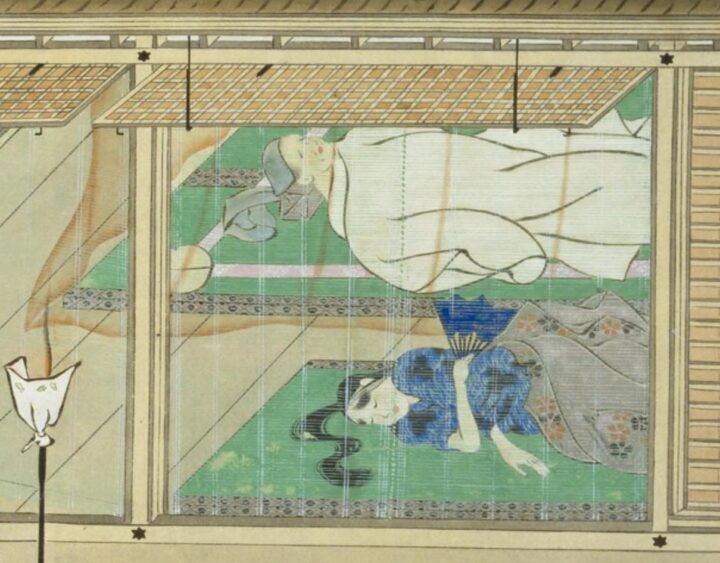
Today, tatami mats are still an essential part of Japanese culture, representing simplicity, harmony, and a connection to nature.
How Are Tatami Mats Used?
Tatami mats are versatile and serve multiple purposes in a traditional Japanese home:
1. Flooring: Used as a soft, natural surface for walking, sitting, and sleeping.
2. Zashiki (a Japanese term that refers to a traditional tatami-matted room in a house, inn, or restaurant): People often use rooms with tatami mats for tea ceremonies, meditation, or special gatherings.
3. Bedding Base: a tatami bed mat provides the foundation for the traditional Japanese bedding system, which includes the shikibuton and futon.
Japanese Tatami Mat and Traditional Bedding: Shikibuton vs. Futon
While tatami mats serve as the flooring, they also play a crucial role in traditional Japanese sleeping arrangements. Let’s break it down:
1. Shikibuton
People place a shikibuton, a thin mattress, directly on a tatami mat to create a firm sleeping surface. They roll it up and store it during the day, making it both practical and space-saving. As the base layer for sleeping, the shikibuton pairs perfectly with the firm yet slightly cushioned tatami mat. Manufacturers typically make shikibutons from cotton or wool, which offer natural breathability.
2. Futon
The term futon refers to the entire Japanese bedding system, which includes:
- Shikibuton: The mattress.
- Kakebuton: The duvet or comforter used for warmth.
- Makura: A pillow, often filled with buckwheat hulls.
- Versatility: The futon system is lightweight and compact, allowing you to roll up the components and free up space during the day.
Key Differences
- Shikibuton: Specifically refers to the mattress.
- Futon: Refers to the full bedding set, including the mattress, duvet, and pillow.
Benefits of Tatami Mats
1. Natural Comfort
Tatami mats offer a slightly firm yet springy surface that feels comfortable underfoot and as a base for sleeping.
2. Regulates Humidity
The natural rush grass absorbs and releases moisture.
3. Eco-Friendly
Made from renewable materials, tatami mats are a sustainable choice for those looking to minimize their environmental impact.
4. Space-Saving
When paired with a futon system, tatami mats support a minimalist lifestyle by allowing spaces to serve multiple purposes.
How to Care for Tatami Mats
To keep your tatami mats in great condition, you should follow a few simple care tips. First, vacuum them regularly using a soft brush attachment to gently clean the woven surface without causing damage. Additionally, because tatami mats are sensitive to moisture, it is important to air out the room and ensure proper ventilation to prevent mold or mildew. Finally, avoid wearing shoes on the mats; only barefoot or socked feet should walk on them to preserve their integrity and maintain their appearance.
Tatami Mats in Modern Living
While tatami mats are deeply rooted in tradition, they have also found a place in modern homes worldwide. They are popular for creating calm and natural environments for mindfulness in meditation spaces. Additionally, tatami mats work well in minimalist bedrooms, where they pair seamlessly with a shikibuton for a pared-down sleeping setup. Furthermore, they are ideal for multi-use rooms, as their versatility makes it easy to transition a space from a sleeping area to a workspace or dining area.
The tatami mat is more than just flooring—it’s a symbol of Japanese culture and a testament to the beauty of simplicity and functionality.
Paired with a shikibuton or futon, it offers a unique and healthy sleeping solution that supports mindfulness, sustainability, and minimalist living.
Whether you’re looking to incorporate Japanese aesthetics into your home or improve your sleep quality, tatami mats are a timeless and versatile choice. Ready to bring a piece of tradition into your modern life? Start with a tatami mat!

Are you tired of tossing and turning at night? Or maybe you’re waking up with nagging neck pain that just won’t go away? The way you position your pillow while sleeping could be the culprit. Yep, that’s right—your pillow’s position can make or break your sleep quality. In this guide, we’ll explore the proper pillow position for sleeping so you can enjoy restful nights and wake up feeling refreshed.
Why Pillow Positioning Is So Important
You might not give it much thought, but the way your pillow is positioned plays a crucial role in your sleep health. A properly positioned pillow supports the natural curve of your spine, keeps your neck in alignment, and helps prevent discomfort. If you don’t position your pillow properly, you might experience issues like neck pain, headaches, or even back problems. But with the right positioning, your pillow can help you achieve deeper, more restorative sleep.
How to Choose the Right Pillow for Optimal Positioning
Before we dive into the proper pillow position for sleeping, let’s talk about selecting the right pillow. Because no matter how well you position it, the wrong pillow won’t give you the support you need.
- Sleep Position: Your sleep position is the first thing to consider. Side sleepers typically need a firmer, higher pillow to fill the space between their head and the mattress. Back sleepers benefit from a medium-thickness pillow that supports the neck without pushing the head too far forward. Stomach sleepers often need a very thin pillow—or none at all—to keep the spine in a neutral position.
- Pillow Filling: The fill inside your pillow plays a huge role in comfort and support. Memory foam pillows mold to your head and neck, offering personalized support, while down or feather pillows provide a soft, cushioned feel. If you’re looking for something a bit different, consider buckwheat pillows—they’re filled with natural buckwheat hulls, which allow for excellent airflow and customizable firmness.
- Pillow Loft: Loft refers to the height or thickness of your pillow, which is crucial for maintaining proper head and neck alignment with your spine. The right loft keeps your head in a neutral position, avoiding strain. If you’re unsure about the ideal loft for your needs, consider an adjustable pillow with a zippered opening. These pillows allow you to add or remove fill, customizing the loft to suit your comfort and sleeping position perfectly.
Proper Pillow Position for Different Sleeping Styles
Now that you’ve got the right pillow, let’s get into the best way to position it based on your preferred sleeping style.
1. For Back Sleepers:
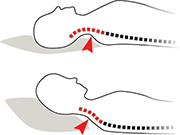
- Pillow Positioning: If you sleep on your back, place your pillow so that it supports the natural curve of your neck. Your head should rest comfortably in the center of the pillow, without tilting too far forward or backward. This position helps keep your spine aligned.
- Additional Support: To further reduce strain on your lower back, consider placing a small pillow or rolled towel under your knees.
2. For Side Sleepers:
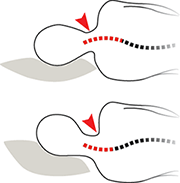
- Pillow Positioning: Side sleepers need a pillow that fills the space between their ear and the mattress, keeping the head and neck in a straight line with the spine. The pillow should be thick enough to maintain this alignment, but not so thick that it causes your head to tilt.
- Arm Placement: Keep your arms parallel to your body or hug a pillow to avoid shoulder strain. If you’re prone to shoulder pain, placing a pillow between your knees can also help maintain proper alignment.
3. For Stomach Sleepers:
- Pillow Positioning: Stomach sleepers should use a very thin pillow or none at all to prevent excessive arching of the neck. By minimizing the height under your head, you help keep your spine in a more neutral position.
- Additional Support: Consider placing a pillow under your pelvis to maintain a natural curve in your lower back, reducing strain on your spine.
Fluff, Squish, and Shape: Achieving the Proper Pillow Position for Sleeping
When it comes to getting that perfect pillow shape, malleable pillow filling like down or buckwheat work well. Moldable pillow fillings like these allow you to fluff, squish, and shape your pillow exactly how you like, giving you just the right support where you need it. You can easily adjust these pillows on the fly. On the other hand, memory foam pillows don’t offer the same flexibility. They’re firm and hold their shape, which can be great for consistent support but doesn’t allow for much customization. So, if you’re someone who likes to mold your pillow into the perfect nest, down or buckwheat might be the way to go!
Common Mistakes to Avoid with Pillow Positioning
It’s easy to position your pillow incorrectly. Avoid these common mistakes:
- Pillow Too High or Too Low: The height of your pillow (loft) is crucial. A pillow that’s too high can push your neck upwards, while one that’s too low can cause your neck to sink. Both scenarios can lead to discomfort and a restless night.
- Ignoring the Lifespan of Your Pillow: Over time, most pillows lose their shape and support, which can negatively impact your sleep quality. Traditional pillows need to be replaced more frequently, but if you’re using a buckwheat pillow, you’re in luck—they tend to last much longer, maintaining their support and comfort for years with proper care. If your pillow feels flat or unsupportive, it’s probably time to consider a replacement.
- Incompatible Mattress and Pillow Combo: Your mattress and pillow should work together to support your body. A mattress that’s too soft or too firm can throw off your alignment, even if your pillow is positioned correctly.
The Bottom Line on Pillow Positioning
Achieving the proper pillow position for sleeping can significantly enhance your sleep quality and overall well-being. By keeping your spine aligned and providing the right support, you can wake up feeling refreshed and free from discomfort. So, take a moment to assess your pillow and sleep habits, make any necessary adjustments, and get ready for some sweet, restful sleep!
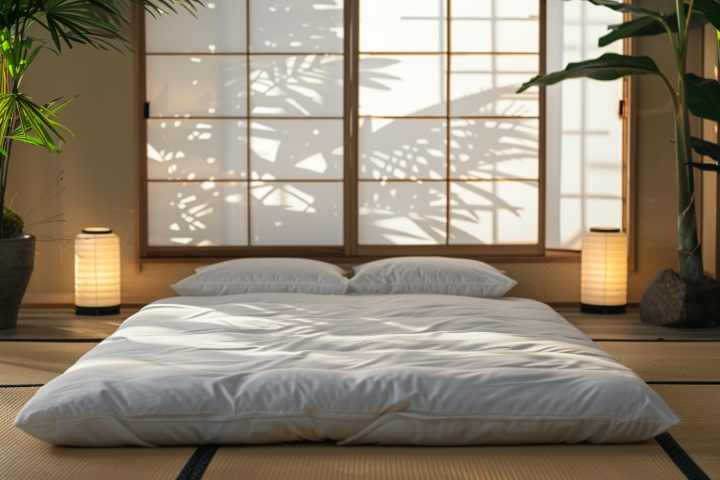
There is a striking cultural divide between East and West where sleeping habits are concerned. We in the West are accustomed to beds raised on frames topped with soft, thick mattresses. Conversely, the Japanese tradition embraces a more grounded approach to sleep, literally, with firm mattresses placed directly on the floor.

Futon: Traditional Japanese Bed Benefits
A traditional Japanese bed is commonly referred to as a futon. Futons are firm mattresses designed to be laid on the floor and are paired with:
- sobakawa or buckwheat pillows for neck and head support, and
- tatami mats that give another layer of support and promote airflow (preventing mold). They’re sort of like carpets.
1. Versatile and Economical Comfort
Their use dates back to the 17th century, when Japanese homes needed to be versatile. With space at a premium, rooms served various purposes by day and night, necessitating furniture that was as easy to stow away as it was functional. The futon, lightweight and easily moved, emerged as an elegant solution to these space challenges. It was also affordable, making it a popular choice across social strata.
2. Cool Rest
The science is pretty simple: warm air rises. Thus sleeping on the floor will help to keep you comfortably cool all night long as the warm air in your bedroom rises to the ceiling.
3. Enhanced Sleep Posture (Supposedly)
A soft mattress may cause your spine to misalign, potentially resulting in back pain and other problems. It’s true. Many modern mattresses can be excessively soft, causing them to dip in the center. This lack of support for the lower back forces it to bear our weight all night.
Conversely, a firm surface, such as a futon on the floor, supports your spine in a neutral alignment, contributing to better posture overall (and theoretically less discomfort)
Despite the benefits of sleeping on the floor some studies show that a mattress that is too firm can cause discomfort! So which is it? Is sleeping on the floor good for you or not?
Comfort is subjective.
Some people sleep best on softer surfaces while others prefer firmer ones. Most sleep experts agree that mattress firmness is a personal choice. There is no right mattress for everyone. Thus most manufacturers produce a variety of mattresses with varying firmness.
In exploring the history of Japanese sleep hygiene, we can see how our cultural backdrop shapes our perception of comfort. The stark differences in mattress design between eastern and western cultures illustrates that the way we sleep is deeply influenced by the conventions and traditions of society.
So, why do Japanese people sleep on the floor? It’s all about blending tradition, practicality and comfort.
The use of futons on tatami mats isn’t just a nod to cultural heritage; it’s a smart, space-saving choice that can be surprisingly comfy. Plus, it’s a great way to keep things simple and minimalist in the bedroom. This sleeping style, deeply rooted in Japanese culture, offers a unique approach to rest that contrasts with the plush beds we’re accustomed to.
Good night!
Or in Japanese, おやすみ (Oyasumi)
Learn More About Japanese Comfort Traditions…
In addition to sleeping on the floor, it’s common in Japan for people to sit on the floor for meals, tea ceremonies, and other activities. A popular seating option is the floor pillow. These floor pillows are frequently filled with buckwheat hulls, providing firm, comfortable support that molds to the body’s shape. The use of buckwheat pillows for both sleeping and sitting is rooted in their ability to promote comfort and natural posture, making them a versatile and ergonomic option.
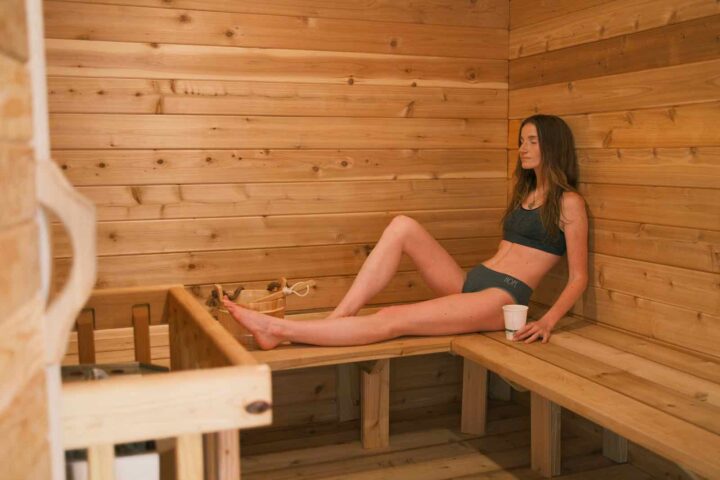
Scientific evidence suggests that regular sauna use can improve sleep by increasing deep sleep cycles, boosting melatonin production, and decreasing stress levels.
I built a sauna in my basement last year and almost immediately noticed that I slept better and longer when I started taking a sauna before bed. I wasn’t aware this was considered one of the benefits of sauna use, but the improvement was obvious to me. Most of us recognize the importance of a good night’s sleep for our health and well-being, so I looked into the science of taking a sauna before bed and its affect on sleep. Sure enough, scentific research reveals a relationship between heat exposure and better sleep. There are a few specific mechanisms at work when understanding how saunas improve sleep.
Sauna Significantly Increases Deep Sleep
Scientific studies indicate that regular sauna bathing can positively impact sleep patterns. Sleep is understood to have three different stages, identified through brain-wave patterns, eye movements, and muscle activity. Non-rapid eye movement (NREM) stage 3 sleep, better known as “deep sleep” or slow-wave sleep is an essential stage for restorative sleep. This stage is believed to be important for physical restoration and cognitive function. Research indicates that heat therapy such as regular sauna use is associated with an increase in deep sleep stages, highlighting its potential as a valuable sleep aid.
Sauna Can Increase Melatonin
Sauna use has been associated with an increase in melatonin production. Melatonin is a hormone produced by the pineal gland in the brain, and it plays a crucial role in regulating the sleep-wake cycle. Several studies have explored the impact of sauna bathing on melatonin levels, suggesting a potential link between sauna use and the modulation of this sleep-regulating hormone.
The body’s circadian rhythms play a vital role in regulating sleep-wake cycles. Sauna use has been linked to the modulation of circadian rhythms, influencing the release of melatonin. A study in Chronobiology International (Leppäluoto et al., 2005), titled “Endocrine effects of repeated sauna bathing,” investigated the hormonal changes induced by sauna bathing. The study observed increased melatonin production following sauna sessions, suggesting a potential mechanism by which saunas contribute to improved sleep onset and maintenance.
Stress Reduction from Sauna Use Before Bed
We all experience stress in day-to-day life. Luckily, the sauna experience is synonymous with relaxation, and its impact on stress reduction is well-documented. Stress and anxiety are significant contributors to sleep disturbances. A study published in the Journal of Applied Physiology (Hannuksela & Ellahham, 2001) highlighted the role of sauna bathing in reducing cortisol levels, the hormone associated with stress. By promoting a state of relaxation, saunas can alleviate stress and, consequently, improve sleep quality.
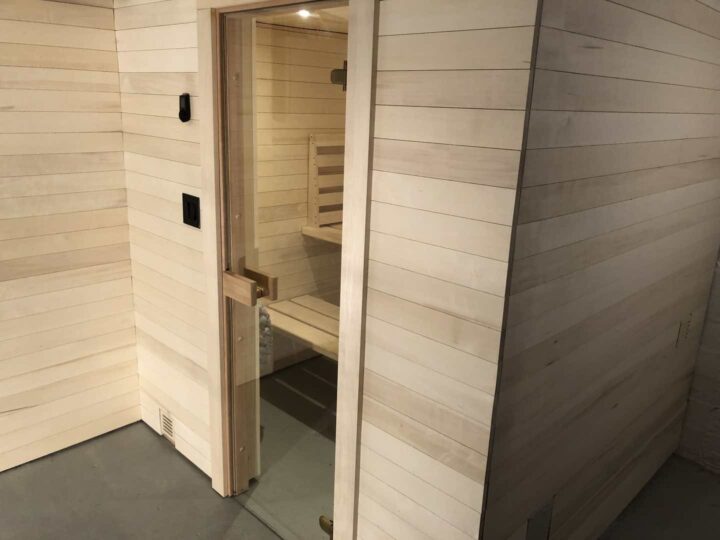
Temperature Regulation and Sleep
Sauna use involves exposing the body to high temperatures followed by a cooling-off period. This process not only induces overall relaxation, but also contributes to a drop in core body temperature. The subsequent cooling phase aligns with the natural decline in temperature that occurs before sleep, potentially promoting better sleep quality.
Do you have to sauna before bed to get sleep benefits?
Studies I read simply research “regular” sauna bathing or heat therapy – measured as some combination of temperature, duration and frequency. It appears that health benefits are especially related to frequency, so more frequent use seems to increase the benefits. It’s not necessary to sauna immediately before bedtime to reap the benefits. In fact, most recommendations are to sauna at least 1-3 hours prior to bedtime to allow your body to completely cool down after heat exposure. I typically sauna in the late afternoon, hours before going to sleep. The key is to use the sauna regularly, at whatever time of day works best for you. While there are no guarantees that using the sauna will cure your insomnia, my personal experience is that my sleep has genuinely improved since making the sauna part of my regular routine.
Sources
- https://pubmed.ncbi.nlm.nih.gov/2578367/
- https://www.ncbi.nlm.nih.gov/pmc/articles/PMC6015540/
- https://pubmed.ncbi.nlm.nih.gov/3788622/
- https://pubmed.ncbi.nlm.nih.gov/11165553/
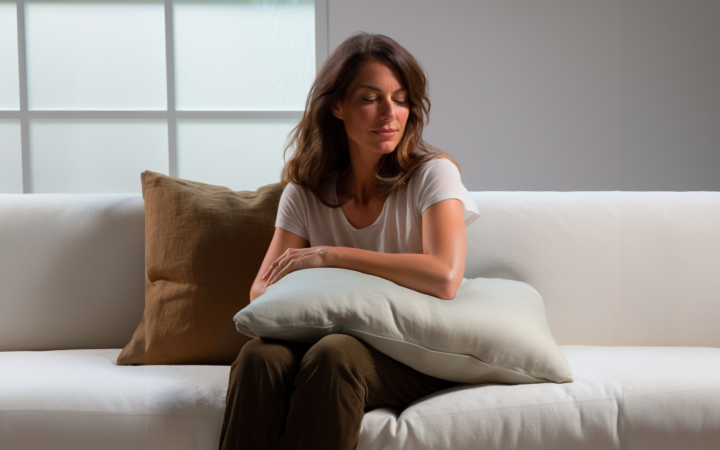
Hugging a weighted pillow is like experiencing a gentle, enveloping embrace. The uniform pressure creates an instant sense of calm and coziness. It’s like a reassuring pat on the back, telling you, “You’re doing great, and everything’s going to be just fine.”
– Luna Dreamweaver, Blissville, CA
This consumer’s description might sound a little silly, but it’s surprisingly accurate. Weighted pillows have an uncanny knack for making you feel snug and secure. They may not literally understand your feelings, but the evenly distributed pressure of a weighted pillow does provide a genuine sense of relaxation and tranquility.
This feeling is a manifestation of the well-documented principle of Deep Pressure Stimulation (DPS), which has been proven to reduce stress, alleviate anxiety, and enhance overall well-being.
You’ve probably already heard about weighted blankets. Growing awareness of the benefits of DPS and its positive effects on mental health and well-being have made them a very popular story in the media. As these blankets have become more widely available, they’ve garnered a dedicated following. The surge in interest reflects a growing awareness of the importance of self-care and the pursuit of a more balanced and peaceful life, turning weighted blankets into a soothing symbol of modern well-being.
Like their blanket counterparts, weighted pillows apply uniform weight and pressure to the body. Drawing from DPS research and user feedback, these pillows have been found to provide the same comfort and relief that weighted blankets do.
The Magic of Deep Pressure Stimulation (DPS)
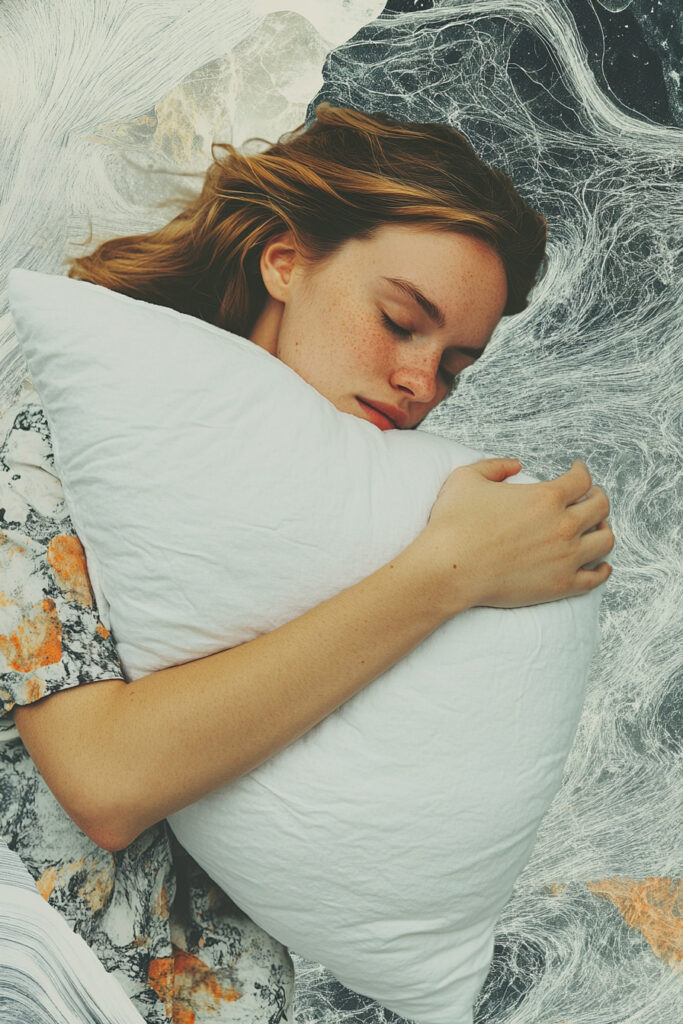
Evidence shows that Deep Pressure Stimulation (DPS) offers a myriad of benefits. Apparently it’s the concept of “even pressure” that unlocks its therapeutic potential. Consistent pressure, whether from a weighted blanket, vest, or pillow, activates the body’s parasympathetic nervous system, signaling it to relax and reduce stress. MAGIC!
Weighted pillows can offer a wide range of benefits, including:
- Stress Reduction: DPS has a calming effect on the nervous system, reducing the production of stress hormones like cortisol, and promoting relaxation.
- Improved Sleep: Many people find that DPS helps them fall asleep faster and enjoy deeper, more restful sleep by reducing restlessness and nighttime awakenings.
- Anxiety Relief: The soothing pressure from DPS can alleviate symptoms of anxiety.
- Mood Enhancement: DPS is associated with increased serotonin and dopamine production, which can lead to improved mood and a sense of well-being.
- Sensory Regulation: DPS is beneficial for individuals with sensory processing disorders, such as autism or ADHD, as it can help modulate sensory input and reduce sensory overload.
- Pain Relief: DPS can alleviate discomfort and pain in conditions such as fibromyalgia, arthritis, and muscle tension by promoting relaxation and reducing muscle tension.
- Focus and Attention: Some individuals, particularly those with ADHD, find that DPS can improve focus and concentration.
- Emotional Regulation: DPS can help individuals manage and regulate their emotions by promoting a sense of calm and emotional stability.
Innovative Uses of Weighted Pillows
Weighted pillows are being creatively used in various therapeutic settings. Occupational therapists often incorporate weighted pillows into sensory rooms and therapy sessions to help individuals with autism or sensory processing disorders achieve calm and focus. Additionally, some people use weighted pillows as a meditation aid, placing them on their lap or shoulders to create a grounding effect that enhances mindfulness practices. These versatile pillows can also serve as ergonomic supports during work or travel. They can alleviate tension in the lower back or neck when used as a cushion for chairs or car seats. As interest in weighted products continues to grow, these innovative applications highlight the adaptability and potential benefits of weighted pillows.
What are My Weighted Pillow Options?
Most weighted pillows are filled with materials like:
- glass beads,
- plastic pellets,
- buckwheat hulls, or
- other dense pillow filling types.
The filling in these pillows is notably heftier than the types used in traditional bed pillows.
How to Choose the Right Weighted Pillow:
- Materials: Pay attention to the materials used in the pillow’s cover. It should be durable and breathable. Weighted pillows are considerably heavier than traditional pillows and thus require a more durable cover. We recommend breathable organic cotton and double-stitched seams!
- Cover Type: Check if the pillow’s cover is removable and machine washable. This feature can make maintenance and hygiene more convenient. A zippered opening that allows the filling to be removed before a wash is a must for most weighted pillows.
- Weight: Weighted pillows come in various weight options, typically ranging from a few pounds to over 10 pounds.
- Size: Weighted pillows are available in different dimensions. Consider the size of the pillow in relation to your bed and your own body size for the best fit.
What weighted pillow do we recommend? A buckwheat pillow of course!
A buckwheat pillow’s unique hull filling makes it an excellent choice as a weighted pillow. The natural weight of buckwheat hulls provides a gentle and evenly distributed pressure. Additionally, buckwheat hull filling is a superior alternative to petrochemical-produced pillow filling like plastic beads for several reasons:
- All-Natural: Buckwheat hulls are a natural, plant-based material, free from potentially dangerous synthetic chemicals.
- Breathability: Buckwheat hulls allow for better air circulation, helping regulate temperature and preventing the buildup of heat and moisture, which can be a concern with some synthetic fillings.
- Eco-Friendly: Choosing buckwheat hulls promotes sustainability as it reduces reliance on non-renewable petrochemical resources. Buckwheat is a 100% Compostable and renewable resource.
- Durability: Buckwheat hulls are known for their long-lasting nature, reducing the need for frequent pillow replacements. Mother earth and your wallet will both approve.
Buckwheat pillows provide a safe and environmentally friendly option for those seeking all the benefits of a weighted pillow. A buckwheat pillow will provide a soothing and calming sleep experience, reducing stress and promoting a restful night’s sleep while prioritizing safety and sustainability.
What size and weight should I get?
When choosing a weighted pillow, opt for a weight/dimension that offers comfortable pressure relative to your body size. It should feel comforting, not restrictive; you should be able to easily reposition your pillow. Thus for children aged 3-12, a smaller pillow weighing 3-6 pounds is generally suitable, while adults will likely benefit from a larger pillow around 10 pounds. Some will prefer a weighted body pillow, which can weigh 14 pounds or more (these things can pretty hefty and are best for use in your bed).
- Children & Adults 14×20″ and 4 lb.
- Adults 20×26″ and 10 lb.
- Adults (weighted body pillow) 20×36″ and 14 lb.
Alternatively, you can make your own. It’s an easy way to save yourself some money and a fun project for your next rainy weekend: How to Make a Weighted Pillow

Choosing the Right Pillow: Your Buckwheat Pillow Buying Guide
Choosing the right pillow is essential for ensuring you get the restful sleep you need. Buckwheat pillows have become increasingly popular in recent years. As a result, a ton of companies have sprung up to sell them. The many different options are overwhelming. In this buckwheat pillow buying guide, we will take a closer look at buckwheat pillows and why our product, Hullo, is the best choice on the market.
Understanding Buckwheat Pillows
Buckwheat pillows are filled with, you guessed it, buckwheat hulls, the outer protective shells of buckwheat seeds. Buckwheat hulls’ unique shape makes it excellent pillow filling. The individual hulls’ rough edges grip one another, enabling your pillow to conform perfectly to the shape of your head and neck, eliminating any uncomfortable pressure points. Traditional pillows can lose their shape and support over time, while buckwheat pillows offer consistent and comfortable support all night long.
Buckwheat hull filling is also breathable. They allow air to circulate through your pillow, keeping you cool throughout the night.
Finding the Perfect Buckwheat Pillow
1. Assessing the Quality of Components
- Fabric case — Opt for a breathable and durable organic cotton fabric that keeps your pillow comfortably cool while preventing rips and tears. Buckwheat hulls are not light (about 10 lb. for a standard size pillow), so your pillow’s seams should be double-stitched. A ripped seam can make quite a mess! Hullo utilizes a 7 oz/yard organic cotton twill fabric, striking the ideal balance between comfort and durability.
- Zipper — a high-quality zipper will keep your pillow’s buckwheat hulls where they belong — inside your pillow. Individual buckwheat hulls are quite small and can get past a cheap non-locking zipper or one that is improperly stitched.
- Buckwheat Hulls — The right hulls for use in a pillow are not easy to find. They should be vacuum-cleaned, intact (not crushed), and of adequate size to ensure breathability. With every purchase of buckwheat hulls from our suppliers, we painstakingly inspect all sources and purchase only the very best available.
Our commitment to quality ensures that your Hullo pillow will last for years, providing excellent support and comfort every night.
2. Emphasizing Sustainability
Sustainability plays a pivotal role in selecting a buckwheat pillow. At Hullo, we prioritize eco-friendly practices throughout our production and shipping processes.
- Renewable and Compostable Materials — Our buckwheat pillows are crafted using renewable, compostable, and organic materials, minimizing their environmental impact compared to traditional pillows that end up in landfills for hundreds of years.
- Durability and Replaceable Filling — Hullo pillows are designed to last, with easily-replaceable filling thanks to its zippered opening. By offering a long-lasting product, we reduce resource consumption and contribute to a more sustainable future.
- Environmentally-Friendly Production and Transportation — From fabric cases to buckwheat hulls and cardboard boxes, Hullo prioritizes locally sourced materials, significantly reducing energy waste and pollution generated during transportation.
3. Additional Benefits: Fast, Free Shipping, and 60-Day Return Window
Hullo ships free via UPS Ground to the 48 Contiguous United States. Every Order. Every Day.
We want you to be completely satisfied with your Hullo pillow, and we stand behind our product with a generous return policy. Try Hullo for 60 nights. If you’re not happy with the sleep you’re getting with Hullo, just ship it back to us and we’ll refund the purchase price.
In conclusion, when it comes to choosing a buckwheat pillow, Hullo is the clear choice. Our commitment to quality, sustainability, and customer satisfaction ensures that you will get a pillow that provides excellent support, lasts for years, and minimizes your environmental impact. Choose Hullo for the best night’s sleep you’ve ever had.

Neck pain can be a real nuisance, and it’s no surprise that people are always looking for ways to alleviate the discomfort. While there are many different types of pillows on the market, buckwheat pillows have become increasingly popular among those seeking relief from neck pain. Let’s explore the benefits of buckwheat pillows and whether or not they are good for neck pain.
What are Buckwheat Pillows?
Buckwheat pillows are filled with buckwheat hulls. Commonly used in Japanese cuisine, buckwheat is a type of grain. People clean and process the outer shells of the buckwheat grain, the hulls, to create a filling for pillows. Buckwheat pillows are a superior alternative to traditional pillows due to the unique qualities of their hull filling.
Benefits of Buckwheat Pillows
Buckwheat pillows have several benefits that make them a popular choice for those with neck pain. First and foremost, the pillows are adjustable. You can adjust the height and firmness of the pillow to suit your needs by moving the buckwheat hulls around inside the pillow. This means that you can create a custom pillow that provides the support you need to alleviate neck pain.
Another benefit of buckwheat pillows is that they are breathable. The hulls allow air to flow through the pillow, which can help keep you cool and comfortable while you sleep. This is especially important if you tend to get hot at night, as traditional pillows can trap heat and make you feel uncomfortable.
Most importantly, buckwheat hulls are malleable. Buckwheat hull filling will conform perfectly to the shape of your head and neck eliminating uncomfortable pressure points, cradling your head consistently all night long.
Will Buckwheat Pillows Help Relieve Neck Pain?
In short, yes, buckwheat pillows can be good for neck pain. They’re adjustable, provide the support you need, and buckwheat hull fill will keep you comfortably cool while you sleep.
It’s worth noting that buckwheat pillows may not be suitable for everyone. Some people find the pillows to be too firm, while others find them too noisy (the hulls can rustle when you move around on the pillow). However, many people have found relief by using buckwheat pillows, so it’s worth giving them a try if you’re looking for a new pillow.
Conclusion
If you suffer from neck pain, a buckwheat pillow may be a good choice for you. These pillows are adjustable, breathable, and above all, comfortable, making them a popular alternative to traditional pillows. While they may not be suitable for everyone, many people have found relief from neck pain by using buckwheat pillows. Consider trying one out to see if it works for you!

Buckwheat pillows have been gaining popularity in recent years, with many people turning to them as an alternative to traditional down or foam pillows. But are buckwheat pillows comfortable? Let’s explore the features and benefits of buckwheat pillows and help you decide if they’re the right for you…
Firstly, what are buckwheat pillows? Buckwheat pillows are filled with the husks of the buckwheat plant, which are small, triangular-shaped seeds. These seeds are known for their durability, and they don’t compress like traditional pillow fillings. This means that buckwheat pillows can provide better support for your head and neck.
Buckwheat pillow highlights include
- Customizable Support: Buckwheat pillows allow users to adjust the filling to their desired level of firmness and support, providing a personalized sleeping experience.
- Improved Sleep Posture: The natural contours of buckwheat hulls allow for proper spinal alignment and reduced pressure points, resulting in a more comfortable and restful sleep.
- Breathable: Buckwheat hulls allow for air circulation, keeping the pillow cool and dry throughout the night. This can be especially beneficial for people who tend to get hot while sleeping.
- Sustainable and Eco-Friendly: Buckwheat is a renewable resource and its use in pillows reduces waste and supports environmentally responsible practices.
So, are buckwheat pillows comfortable?
The answer largely depends on your personal preference. While some people swear by the support and adjustability of buckwheat pillows, others find them too firm or noisy. The sound of the hulls moving around in the pillow can be a dealbreaker for some.
If you’re considering a buckwheat pillow, it’s important to give it a try before making a purchase. Look for a retailer that offers a trial period, or try a friend’s pillow to get a feel for the texture and support. Keep in mind that it may take some time to adjust to a buckwheat pillow if you’re used to traditional down or foam options.
In conclusion, buckwheat pillows have many benefits that can make them a comfortable option for some people. Their adjustability, breathability, and support make them a great choice for people who struggle with traditional pillow options. However, it’s important to try a buckwheat pillow before making a purchase, as the texture and sound may not be right for everyone.
